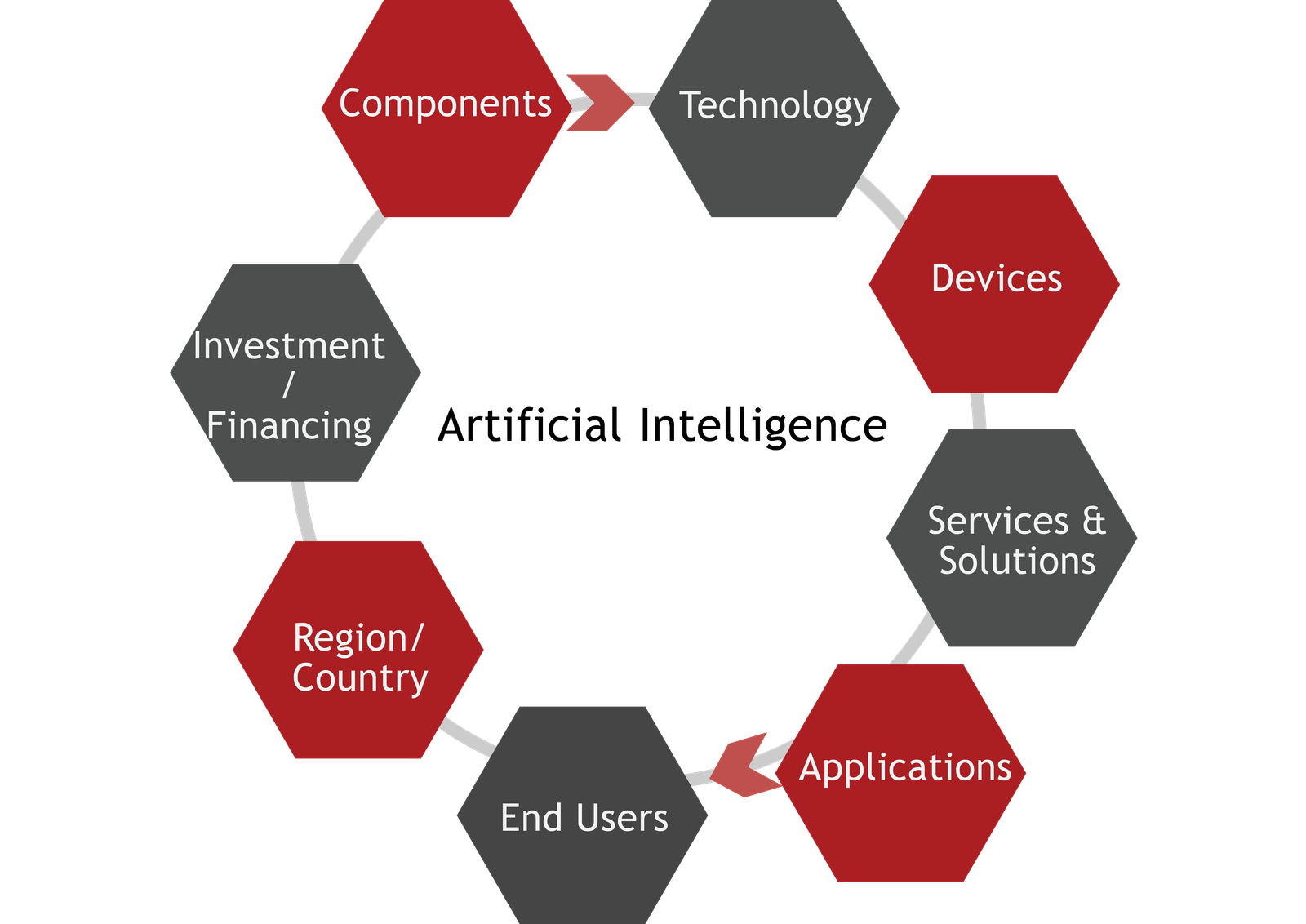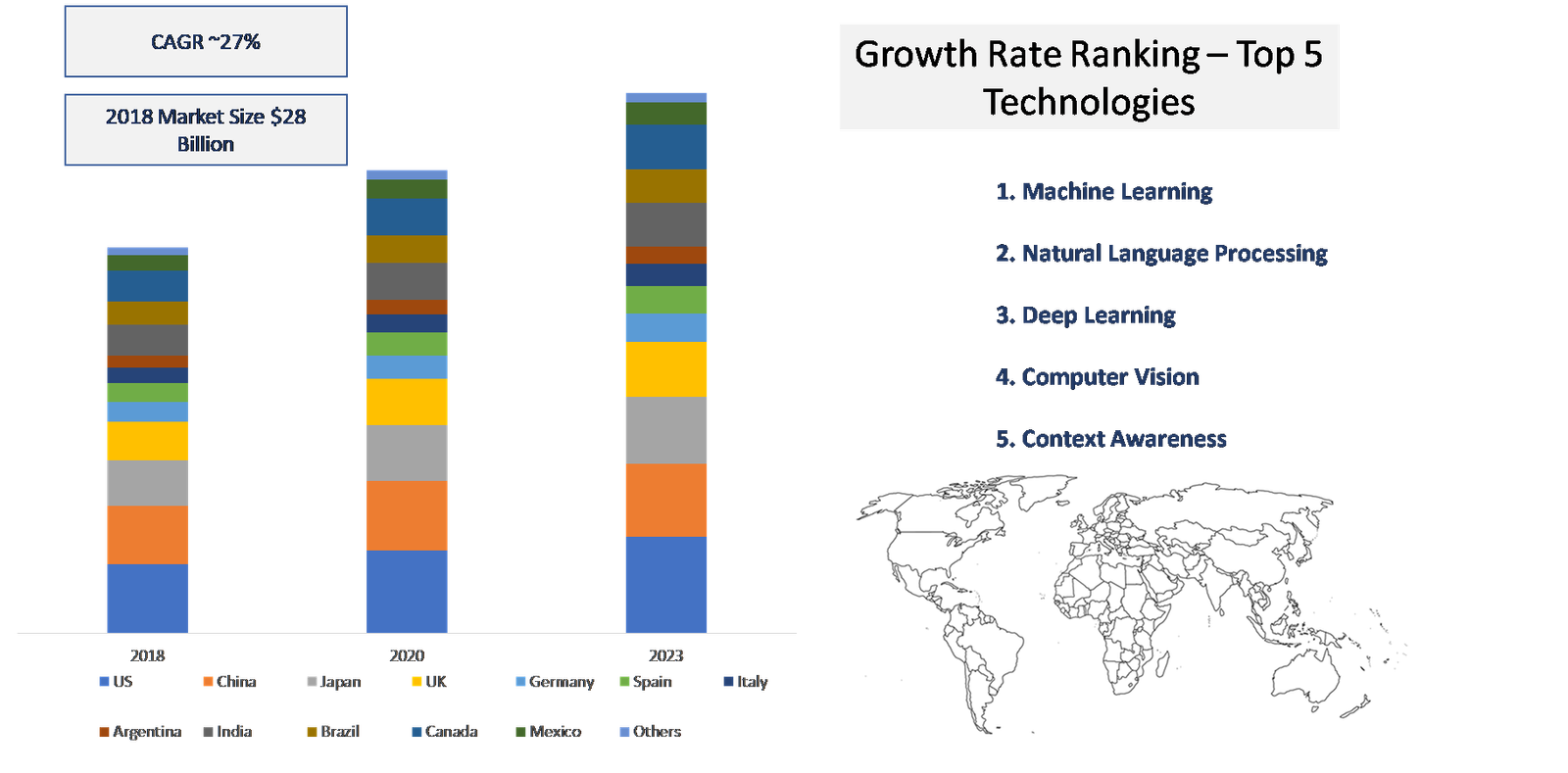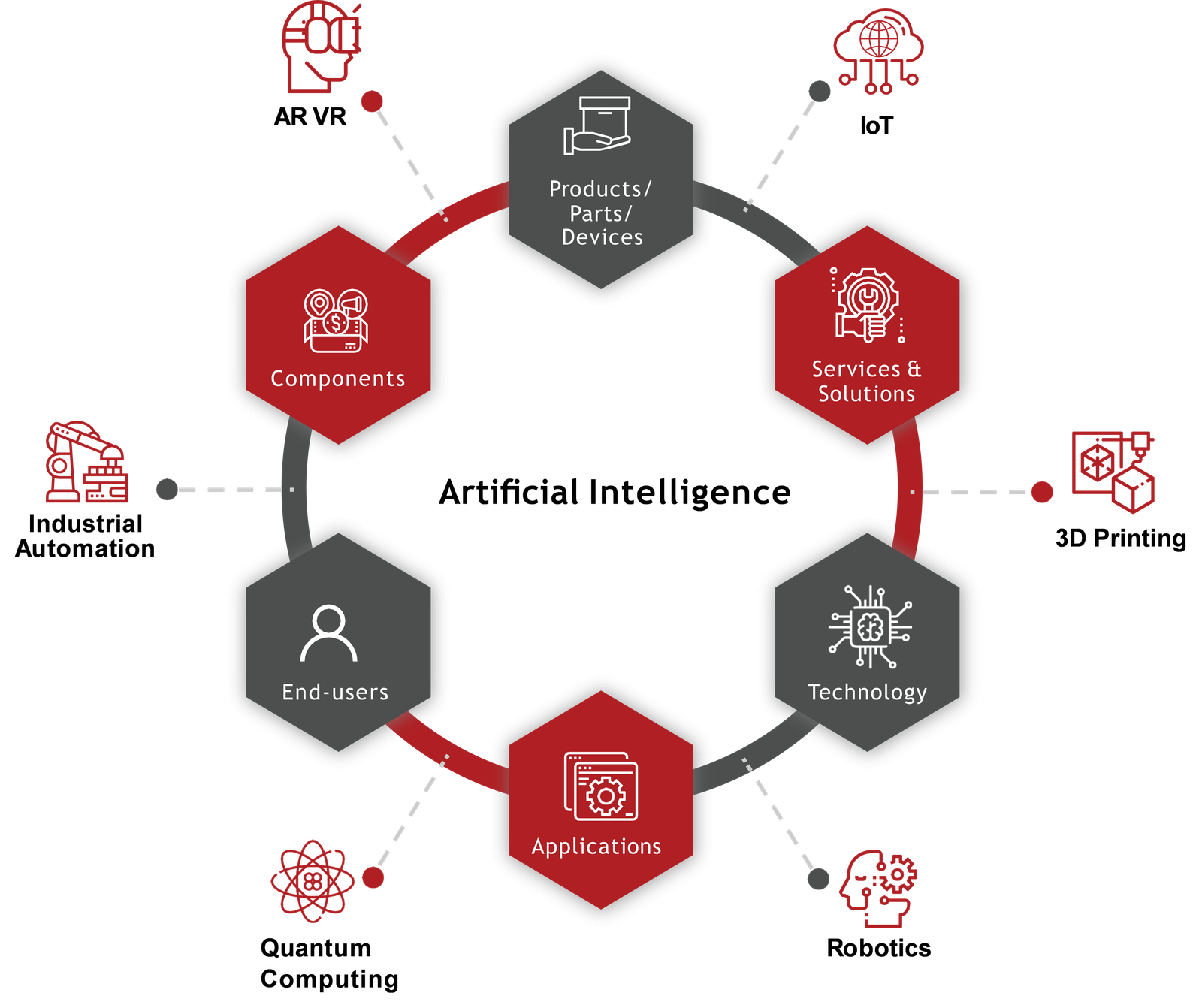Technology has been a major growth driver for most business sectors. Heavy machinery sectors like Oil & Gas, Energy & Power, and Mining have realized the potential of intelligent technological assistance in their operations and tasks, and hence, the growth prospect for Artificial Intelligence (AI) technology ecosystem in nearly all business sectors looks extremely promising for the next 5 years. According to our estimates, by the end of 2023, the AI Technology ecosystem is expected to witness a 25% CAGR, while investments related to Artificial Intelligence (AI) Technology market ecosystem is expected to witness 12X growth rate as compared to 2018. At present, Artificial Intelligence is one of the most popular technologies in the category of “Must to have” technologies. By Q1 -2019, around 2000 AI-focused emerging players have cumulatively raised around $50 billion of funding for growth and expansion funding between 2011 and Q1-2019.

Get a Sample Copy of the report at https://www.alltheresearch.com/sample-request/308
Machine Learning and Natural Language Processing (NLP) are expected to drive the penetration of AI in applications like Predictive Maintenance, Fraud Reduction, Cybersecurity, Virtual Assistance, and many others. Aided by allied markets and interconnected technologies, AI is estimated to impact ~$13 trillion worth of economic activities by the end of 2030.
From a business perspective, key AI technologies like Machine Learning, Deep Learning, NLP, Computer Vision, Robotic Process Automation, Predictive Analytics, and Context Awareness have had a major impact on the competitive landscape since 2018. Whether for trillion-dollar giants like Amazon or Google, or newly formed ventures like Crowdstrike, Zymergen, UiPath, DataRobot, etc., AI technology implementation is becoming imminent. Out of our comprehensively tracked companies, OYO Rooms and Homes, just hours ago, have stated that AI-enabled analytics and Machine Learning in the smart infrastructure management is their current focus area. Even imaging technologies like Facial Recognition are being integrated with the existing hospitality wireframes to offer an enhanced user experience to customers. Even technology giants like Facebook are utilizing NLP to boost the productivity of its developers.
| Components | Services & Solutions | Technology | Applications | End-users |
| Processors | Smartphone & Tablet | Machine Learning | Predictive Maintenance/Self Diagnostics | Logistics |
| Memory | Wearable | NLP | Fraud Reduction | Healthcare |
| Storage | Workstation System | Deep Learning | Cybersecurity | Transportation |
| FPGA | Medical Devices | Context Awareness | Network Security | Automotive |
| ASIC | Pharma/Biopharma | Computer Vision | Network Optimization | Retail |
| Modules | Smart Modules | Predictive Analytics | Customer Analytics | BFSI |
| Imaging Systems | Others | Virtual Assistance | Telecom & Consumer Electronics | |
| Smart Trackers | Network Operations & Monitoring Management | Oil & Gas | ||
| Smart Meters | Security & Surveillance | Others | ||
| Others | Recommendation Engine | |||
| Predictive Merchandising | ||||
| Inventory Management | ||||
| Others |
For AI to flourish, it has been observed that its ecosystem constituent – Technology Hardware - is also being enhanced through components like FPGA, ASIC, Chipsets, and Processors. Hardware players like Qualcomm, ARM, Intel, and Huawei have already started increasing their competitive rivalry in this category, by offering powerful AI processors and chipsets. In terms of growth in the End-users, the automotive industry is driving the market with a CAGR of 23.5%, while Telecom & Consumer Electronics is well placed in terms of value. Key countries like China and the US are expected to reap maximum benefits from AI technology ecosystem by the end of 2026. 18% of the GDP of these two counties is expected to shape up owing to the integration of AI technology in industries like Automotive, Healthcare, and BFSI.

There are many trends that are having an impact on the AI technology ecosystem forecast. These, when evaluated from a company’s perspective, can drive growth. Our numerous consulting projects have generated sizeable synergies across all regions and all sizes of companies.
| Company | Ecosystem Positioning | Total Revenue | Region |
| IBM Corporation | Solution & Service Provider | $ 79 Billion | Global |
| Amazon.com Inc. | Solution & Service Provider | $72.4 Billion | Global |
| Google Inc. | Solution & Service Provider | $136.22 Billion | Global |
| Intel | Hardware Manufacturers and Service Provider | $37 Billion | Global |
| Solution & Service Provider | $55.83 Billion | Global |
Very few markets have interconnectivity with other markets like AI. Our Interconnectivity module focuses on the key nodes of heterogeneous markets in detail. IoT, 3D printing, Smart Sensors, AR-VR, IIoT, and Blockchain markets are some of our key researched markets.

| Trends | Impact on Market |
| Disease diagnosis can be improved to multiple folds by using AI in imaging systems. AI has the potential to transform the delivery of Healthcare | 1.30% |
| FPGA is used for processing high-performance algorithms and workloads. Oil & gas reservoir modeling is one such application where high-performance computing is required. | 1.68% |
| Increasing usage of voice-based commands in Next-Generation Transportation and Logistics industry will fuel the growth of NLP | XX% |

Ask for free product review call with the author

Share your specific research requirements for a customized report

Request for due diligence and consumer centric studies

Request for study updates, segment specific and country level reports
1. Introduction
1.1. Global AI Technologies Market Definition
1.2. Scope of study
1.3. About FABRIC
2. Executive Summary
2.1. Global Market Segmentation
2.2. Global Market Overview
2.2.1. Mega Growth Drivers
2.2.2. Major Growth Blockers
2.3. Global Market Statistics
2.3.1. By Investment
2.3.1.1. AI Technology Industry Player
2.3.1.2. Investment Companies
2.3.2. By Market Revenue / Shipments/ Price Points
2.4. Mega Trends
2.5. Competitive Landscape
2.5.1. SWOT
2.5.2. PEST
2.5.3. Company Ranking
2.6. Market Attractiveness
2.6.1. By Segment Level
2.6.2. By Geography (Region/Country)
2.7. Interconnectivity
2.7.1. Allied/Interconnected Markets
2.7.2. Allied/Interconnected Technologies
2.7.3. Allied/Interconnected Applications
2.7.4. Allied/Interconnected End Users
2.7.5. Allied/Interconnected Companies
3. Global AI Technologies Market Ecosystem Snapshot
3.1. Global AI Technologies Market Ecosystem Broad Heads
3.1.1. Demand Side
3.1.2. Supply Side
3.2. Global AI Technologies Market Segmentation
3.2.1. By Components
3.2.1.1. Processors
3.2.1.2. Memory
3.2.1.3. Storage
3.2.1.4. FPGA
3.2.1.5. ASIC
3.2.1.6. Modules
3.2.2. By Product, Parts & Devices
3.2.2.1. Smartphones and Tablets
3.2.2.2. Wearables
3.2.2.3. Workstation Systems
3.2.2.4. Medical Devices
3.2.2.5. Pharmaceuticals/ Biopharma
3.2.2.6. Hospital Management
3.2.2.7. Smart Modules
3.2.2.8. Imaging Systems
3.2.2.9. Smart Trackers
3.2.2.10. Smart Meters
3.2.2.11. Others
3.2.3. By Services & Solutions
3.2.3.1. Solutions
3.2.3.2. Services
3.2.4. By Technology
3.2.4.1. Machine Learning
3.2.4.2. Deep Learning
3.2.4.3. NLP
3.2.4.4. Computer Vision
3.2.4.5. Context Awareness
3.2.4.6. Predictive Analytics
3.2.4.7. Others
3.2.5. By Application
3.2.5.1. Predictive Maintenance/Self Diagnostics
3.2.5.2. Fraud Reduction
3.2.5.3. Cybersecurity
3.2.5.4. Network Security
3.2.5.5. Network Optimization
3.2.5.6. Customer Analytics
3.2.5.7. Virtual Assistance
3.2.5.8. Network Operations & Monitoring Management
3.2.5.9. Security & Surveillance
3.2.5.10. Recommendation Engines
3.2.5.11. Predictive Merchandising
3.2.5.12. Inventory Management
3.2.5.13. Others
3.2.6. End Users
3.2.6.1. Logistics
3.2.6.2. Healthcare
3.2.6.3. transportations
3.2.6.4. Automotive
3.2.6.5. Retail
3.2.6.6. BFSI
3.2.6.7. Aerospace
3.2.6.8. Telecom & Consumer Electronics
3.2.6.9. Oil & Gas
3.2.6.10. Others
3.2.7. Geographic Overview
3.2.7.1. North America
3.2.7.1.1. U.S.
3.2.7.1.2. Canada
3.2.7.1.3. Mexico
3.2.7.2. Europe
3.2.7.2.1. U.K.
3.2.7.2.2. Germany
3.2.7.2.3. Italy
3.2.7.2.4. Spain
3.2.7.2.5. France
3.2.7.2.6. Rest of Europe
3.2.7.3. APAC
3.2.7.3.1. India
3.2.7.3.2. Japan
3.2.7.3.3. China
3.2.7.3.4. South Korea
3.2.7.3.5. Taiwan
3.2.7.3.6. Rest of APAC
3.2.7.4. RoW
3.2.7.4.1. Middle East
3.2.7.4.2. Africa
3.2.7.4.3. South America
4. Competitive Landscape Mapping by Ecosystem Positioning
4.1. Company by each node
4.2. Vendor Landscaping
5. Ecosystem Level Analysis
6. Global AI Technologies Market Trends
6.1. Trend Mapping
6.1.1. Trend Description
6.1.2. Trend Evaluation
6.1.2.1. Impact
6.1.2.2. Importance
6.1.2.3. Remarks
6.1.3. Trend Outlook (Short, Mid, Long Term)
6.1.4. Trend Company Mapping
6.1.5. Related Global AI Technologies Market Mapping
6.1.6. Trend Region/Country Mapping
7. Overview
7.1 Regulatory Mapping
7.2 Regulatory Impact
7.3 Regulatory Interlinkage
8. Global AI Technologies Market Sizing & Volume
8.1 Cross-segmentation
8.2 Global AI Technologies Market Sizing and Global AI Technologies Market Forecast
8.3 Global AI Technologies Market Volume Analysis
8.4 Average Selling Price Analysis
8.5 Global AI Technologies Market Growth Analysis
9. Competitive Intelligence
9.1. Top Industry Players vs Trend Tagging
9.1.1.1. Importance
9.1.1.2. Trend Nature (Positive/ Negative)
9.1.1.3. Value
9.1.1.4. Interconnectivity for each vendor
9.2. Global AI Technologies Market Share Analysis
9.3. Strategies Adopted by Global AI Technologies Market participants
9.3.1.1. Global AI Technologies Market Strategies
9.3.1.2. New product launch Strategies
9.3.1.3. Geographic Expansion Strategies
9.3.1.4. Product-line Expansion Strategies
9.3.1.5. Operational / Efficiency building Strategies
9.3.1.6. Other Strategies
10. Company Profiling Summary
10.1. Company List & Fundamentals
10.2. Ecosystem Positioning
11. Company Profiles - including the:
11.1. Microsoft
11.1.1. Company Fundamentals
11.1.2. Subsidiaries list
11.1.3. Share Holding Pattern
11.1.4. Key Employees and Board of Directors
11.1.5. Financial Analysis
11.1.5.1. Financial Summary
11.1.5.2. Ratio Analysis
11.1.5.3. Valuation Metrics
11.1.6. Product & Services
11.1.7. Client & Strategies
11.1.8. Ecosystem Presence
11.1.9. SWOT
11.1.10. Trends Mapping
11.1.11. Analyst Views
11.2. Apple
11.3. Amazon
11.4. Google
11.5. IBM
11.6. Cisco
11.7. SAP SE
11.8. Oracle
11.9. CloudMinds
11.10. Nvidia
11.11. Symantec
11.12. Company 12
11.13. Company 13
11.14. Company 14
11.15. Company 15
11.16. Company 16
11.17. Company 17
11.18. Company 18
11.19. Company 19
11.20. Company 20
12. Global AI Technologies Market Events & Rationale
12.1. R&D, Technology and Innovation
12.2. Business & Corporate advancements
12.3. M&A, JVs/Partnerships
12.4. Political, Macro-economic, Regulatory
12.5. Awards & Recognition
12.6. Others
13. Research Methodology and Approach
13.1. Assumptions/ Inferences
13.2. Sources
13.2.1. Primary Interviews
13.2.2. Secondary Sources
13.2.2.1. Key Secondary Webpages
13.2.2.2. Whitepapers
13.2.2.3. Annual Reports
13.2.2.4. Investor/Analyst Presentations
13.3. Appendix
13.4. Contact
14. Ask for Customization
14.1. Sensitivity Analysis
14.2. TAM SAM SOM Analysis
14.3. Other Customization
